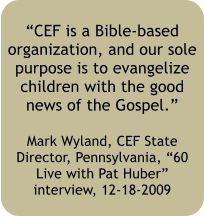Good News Club v. Milford Central School, 533 U.S. 98 (2001)
Widmar v. Vincent, 454 U.S. 263 (1981)
In Widmar v. Vincent, the University of Missouri at Kansas City invoked a policy against religious worship and teaching on campus to deny an evangelical student group’s request for permission to meet on campus. The Supreme Court held that religious worship and teaching were protected under the Free Speech and Association clauses. The University’s “interest in maintaining strict separation” did not provide a compelling basis for excluding the group because it was not necessitated by the Establishment Clause. A policy of nondiscrimination, by contrast, served a secular purpose, avoided entanglement with religion, and did not have the primary effect of advancing religion.
Equal Access Act
In 1984, Congress passed the Equal Access Act. Under the Act, any federally funded secondary school that allows a noncurriculum related student group to meet on school premises during noninstructional time creates a limited open forum for student groups. Such schools cannot discriminate against other noncurriculum related student groups “on the basis of the religious, political, philosophical, or other content of the speech at such meetings.” The Supreme Court upheld the Equal Access Act in Westside Community Schools v. Mergens, 496 U.S. 226 (1990).
The Equal Access Act reflected Congress’s common sense intuition that in a student-led “marketplace of ideas” outside of instructional time, students had a right to organize groups around their belief systems. Prudently, the benefits of the act were limited to student-initiated and student led groups. The Act was also limited to secondary schools. Moreover, schools retained authority under the Act to “maintain order and discipline on school premises, … protect the well-being of students and faculty, and … assure that attendance of students at meetings is voluntary.” In summary, Congress found a way to facilitate equal access in student-led marketplaces of ideas without creating an opportunity for adults to set up indoctrination camps inside elementary schools.
In 2001, the Supreme Court upset that balance.
Good News Club v. Milford Central School, 533 U.S. 98 (2001)
 In fall 1996, Pastor Steve and wife Darlene Fournier of Milford Central Community Bible Church submitted “Use of Facilities” requests to Milford School, a rural K-12 school in Milford, New York, seeking use of the school’s facilities. Milford had a policy opening the school to “social, civic, and recreational meetings and entertainment events, and other uses pertaining to the welfare of the community,” provided the uses were nonexclusive and open to the public. The Fourniers’ proposed purpose for the Good News Club meetings were for “singing songs, hearing a Bible lesson and memorizing scripture.”
In fall 1996, Pastor Steve and wife Darlene Fournier of Milford Central Community Bible Church submitted “Use of Facilities” requests to Milford School, a rural K-12 school in Milford, New York, seeking use of the school’s facilities. Milford had a policy opening the school to “social, civic, and recreational meetings and entertainment events, and other uses pertaining to the welfare of the community,” provided the uses were nonexclusive and open to the public. The Fourniers’ proposed purpose for the Good News Club meetings were for “singing songs, hearing a Bible lesson and memorizing scripture.”
 The superintendent denied the request on the grounds that the club was the equivalent of “religious worship.” Litigation ensued. The district court and the Second Circuit sided with the school, finding that the Good News Club’s activities were “quintessentially religious.” In describing the club’s religious character, the Second Circuit quoted extensive portions of CEF’s “David: A Man After God’s Heart” lesson book (reviewed here) especially the “Israel Demands a King” lesson (reviewed here).
The superintendent denied the request on the grounds that the club was the equivalent of “religious worship.” Litigation ensued. The district court and the Second Circuit sided with the school, finding that the Good News Club’s activities were “quintessentially religious.” In describing the club’s religious character, the Second Circuit quoted extensive portions of CEF’s “David: A Man After God’s Heart” lesson book (reviewed here) especially the “Israel Demands a King” lesson (reviewed here).
 The Supreme Court, in Good News Club v. Milford Central School, 533 U.S. 98 (2001), reversed, holding that barring access to the Good News Club constituted “viewpoint discrimination” under the Court’s longstanding public forum doctrine. Under Milford’s interpretation of its facility use policy, any group that promoted “moral and character development of children” was eligible to use the school building. The Supreme Court held that because Good News Club also taught “moral and character development,” it was equally eligible to use the facilities:
The Supreme Court, in Good News Club v. Milford Central School, 533 U.S. 98 (2001), reversed, holding that barring access to the Good News Club constituted “viewpoint discrimination” under the Court’s longstanding public forum doctrine. Under Milford’s interpretation of its facility use policy, any group that promoted “moral and character development of children” was eligible to use the school building. The Supreme Court held that because Good News Club also taught “moral and character development,” it was equally eligible to use the facilities:
[T]he Club instructs children to overcome feelings of jealousy, to treat others well regardless of how they treat the children, and to be obedient.
Id. at 108. (See related discussion here). The 6-3 majority wrote: “for purposes of the Free Speech Clause we can see no logical difference in kind between the invocation of Christianity by the club and the invocation of teamwork, loyalty, or patriotism by other associations to provide a foundation for their lessons.” Id. at 111. The Good News Club could not be excluded because of its “reliance on Christian principles” for moral and character instruction. Id. Excluding the Good News Club because of its “religious nature” — even if “quintessentially religious,” sectarian, and including worship and prayer — unconstitutionally interfered with Good News Club’s free speech rights.
The Court rejected the argument that the elementary school’s hosting of a Good News Club would violate the Establishment Clause:
The Good News Club seeks nothing more than to be treated neutrally and given access to speak about the same topics as are other groups. Because allowing the Club to speak on school grounds would ensure neutrality, not threaten it, Milford faces an uphill battle in arguing that the Establishment Clause compels it to exclude the Good News Club.
Id. at 114. The Court noted that attendance at the clubs was not mandatory, parental consent was required, “meetings were held in a combined high school resource room and middle school special education room, not in an elementary school classroom,” “[t]he instructors are not schoolteachers,” and it was after school hours. Id. at 116-118. “In the present case, there is simply no integration and cooperation between the school district and the Club.” Id. at 116 n.6. And even if there was some danger that schoolchildren would perceive state endorsement of religion through the Club’s activities, the danger was no “greater than the danger that they would perceive a hostility toward the religious viewpoint if the Club were excluded from the public forum.” Id. at 119.
The Milford decision was flawed on many levels, not least of which was the transformation of the application of public forum doctrine — a doctrine built upon the notion of a “marketplace of ideas” — to the public elementary context, as if an elementary school is a marketplace, religious and secular ideas are equally valid, and elementary children have the intellectual and developmental maturity to resist the high-pressure sales pitches of religious belief peddlers.
It is, however, important to note the limitations of Milford’s holding. While Milford Central School could not open its school broadly to groups focused on “moral and character development” and then exclude the Good News Club merely because of its religious viewpoint, the Supreme Court did not address whether Milford could have excluded the Good News Club for endangering the intellectual, emotional and psychological well-being of its children. (See Facility Use Policy page).
Post-Milford Cases
At the time Milford was decided, there were reportedly nearly 1000 public school Good News Clubs. Aided by litigation from several high-profile evangelical legal groups, that number swelled to nearly 4000 by early 2013. Milford’s reasoning has been extended to give the Good News Club access to school walls, tables at Back-to-School nights, and the distribution of flyers in student backpacks.
2025 www.goodnewsclubs.info. All rights reserved.